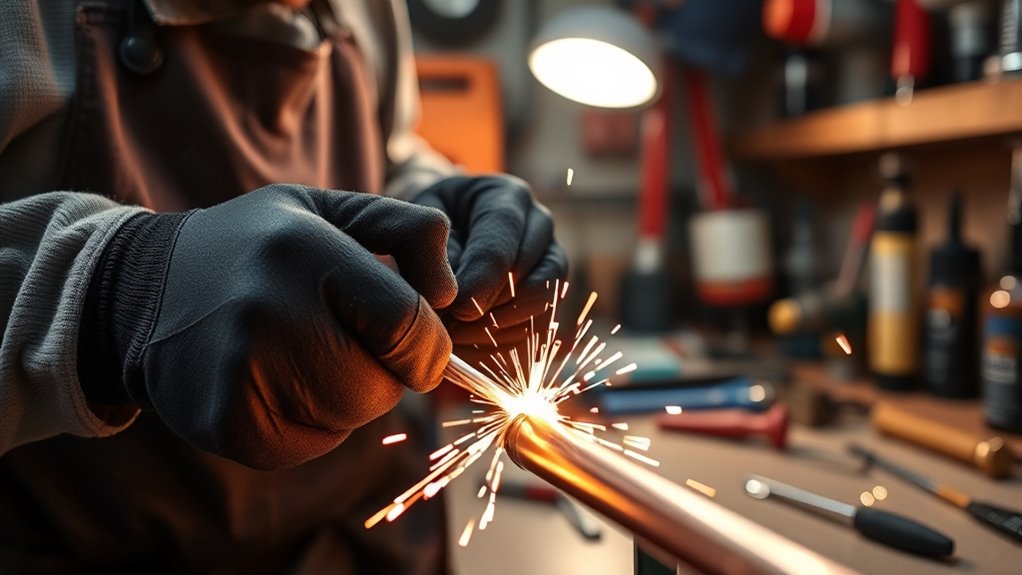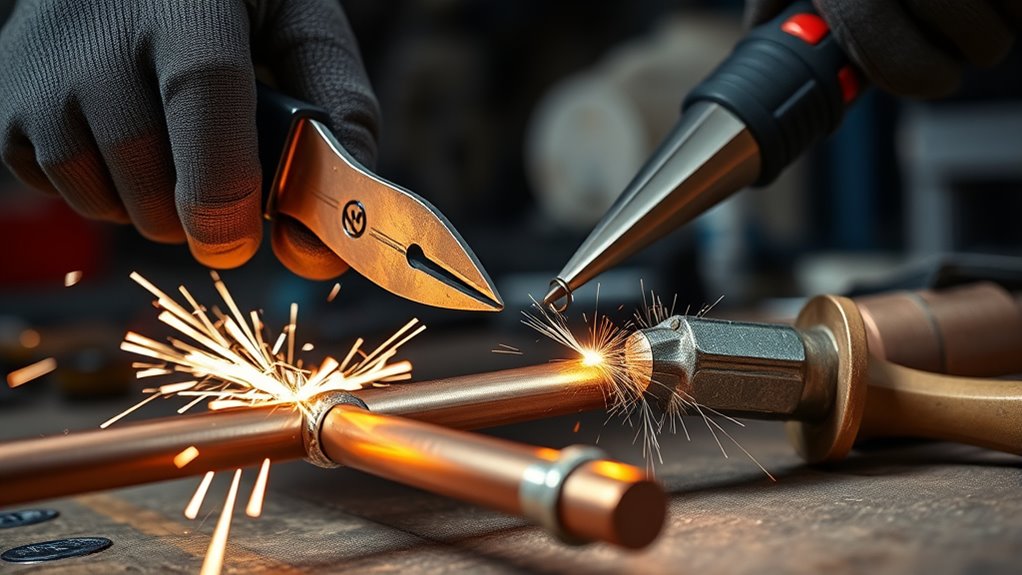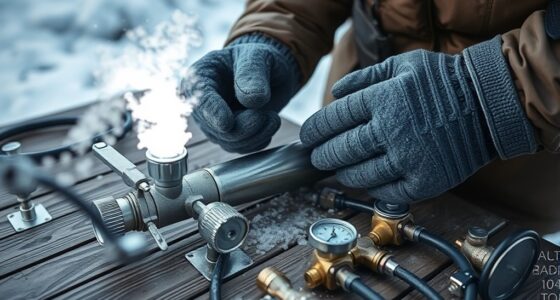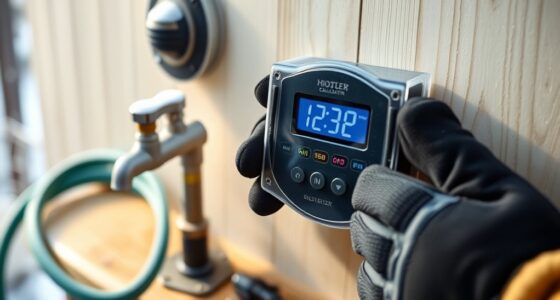When cutting and soldering pipes for a filter installation, prioritize safety by working in a well-ventilated area, wearing gloves and goggles, and keeping a fire extinguisher nearby. Make sure you correctly identify your pipe material and use proper tools for clean, straight cuts. During soldering, apply flux and heat evenly to prevent damage, and allow joints to cool fully before handling. Following these safety tips helps ensure a secure, leak-free connection — learn more to perfect your technique.
Key Takeaways
- Identify pipe material (copper, PVC, PEX) to determine appropriate cutting tools and soldering methods.
- Use proper pipe cutters and ensure clean, straight cuts for leak-proof joints.
- Apply flux and heat evenly during soldering; avoid overheating to prevent damage.
- Wear safety gear, work in ventilated areas, and keep fire safety equipment nearby.
- Test connections with low-pressure water after cooling to check for leaks before full system use.

Installing a filter often requires precise cutting and soldering of pipes to guarantee a secure, leak-free connection. When working with different pipe materials, it’s essential to understand their unique properties to ensure proper handling. Copper pipes are common for their durability and ease of soldering, but if you’re working with PVC or PEX, different techniques and tools are necessary. Before starting, identify your pipe material so you can select the appropriate tools and methods. For copper pipes, clean the surfaces thoroughly and use a wire brush or emery cloth to remove oxidation. Proper cleaning is crucial for creating a strong bond during soldering. With PVC or PEX, you’ll need specialized cutters and fittings designed for those materials, as soldering isn’t applicable.
When it comes to soldering techniques, precision is vital. Begin by measuring and marking where you’ll cut, ensuring your cuts are straight and clean. Use a pipe cutter or a fine-toothed saw designed for the material to create smooth, even edges. Rough or uneven cuts can cause leaks or weak joints. Once the pipe is cut, fit it with a coupling or fitting, and use pipe clamps or holders to keep everything steady during soldering. For copper pipes, apply flux to the joint surfaces to promote proper solder flow. Then, heat the joint evenly with a propane torch until the flux begins to bubble and the metal reaches the right temperature. Apply solder by touching it to the joint; it should melt and flow into the gap, creating a watertight seal. Avoid overheating, which can weaken the pipe or damage fittings. Additionally, understanding the principles of AI-driven personalization in educational tools can help you learn and improve your plumbing skills more effectively.
Safety precautions are essential during this process. Always work in a well-ventilated area, especially when soldering copper pipes, as fumes from flux and solder can be harmful. Wear protective gloves and safety goggles to shield yourself from hot metal and splashes. Keep a fire extinguisher nearby in case of accidental flare-ups. Double-check all measurements before cutting to prevent mistakes that could lead to leaks or the need for rework. Once the soldering is complete, allow the joints to cool naturally before handling or pressurizing the system. Testing the connection with water at low pressure helps identify any leaks early. By paying close attention to pipe material specifics and mastering soldering techniques, you can install your filter securely and safely, ensuring the longevity and proper functioning of your plumbing system.
Frequently Asked Questions
What Are the Best Tools for Cutting Pipes Safely?
You should use a pipe cutter or a hacksaw for safe pipe cutting, ensuring precise pipe cutting techniques. Always wear safety equipment like gloves and safety glasses to protect yourself from sharp edges and debris. A pipe cutter provides clean cuts and minimizes accidents, while a hacksaw is versatile for different pipe sizes. Remember, proper tools and safety gear are essential to keep your work safe and efficient.
How Do I Prevent Pipe Damage During Soldering?
Prevent pipe damage during soldering like handling fragile glass—delicately and precisely. First, guarantee proper surface preparation by cleaning the pipe thoroughly and removing any debris or corrosion. Apply pipe insulation to protect nearby surfaces and prevent accidental heat transfer. Keep the flame steady and focused on the joint, avoiding excessive heat that could warp or weaken the pipe. This careful approach safeguards your pipes and ensures a successful soldering job.
What Safety Gear Is Essential for Pipe Cutting and Soldering?
You should always wear protective eyewear to shield your eyes from sparks, debris, and hot solder. Heat-resistant gloves are essential to protect your hands from burns and hot pipes during cutting and soldering. Additionally, consider wearing long sleeves and a mask to prevent inhaling fumes. These safety gear items help you work confidently while minimizing the risk of injury, ensuring your project stays safe and successful.
How Do I Handle Unexpected Pipe Leaks During Installation?
Imagine the sudden drip echoing like a ticking clock—stay calm. Quickly, shut off the emergency shutoff valve to stop the leak, then use leak containment materials like rags or a bucket to catch drips. Inspect the joint carefully, re-solder if needed, and double-check for leaks before restoring water flow. Acting swiftly prevents damage and keeps you safe during unexpected pipe leaks.
Can I Solder Pipes in Confined or Poorly Ventilated Spaces?
You can solder pipes in confined or poorly ventilated spaces, but you must prioritize ventilation concerns and confined space safety. Guarantee proper ventilation by opening windows, using exhaust fans, or portable ventilation equipment. Wear appropriate protective gear, and work cautiously to prevent buildup of fumes. If ventilation is inadequate, consider postponing soldering or relocating to a better-ventilated area to avoid health risks from toxic fumes.
Conclusion
Remember, safety always comes first when cutting and soldering pipes for filter installation. Wear protective gear, work in a well-ventilated area, and follow proper techniques to prevent accidents. Did you know that according to the CDC, plumbing-related injuries account for nearly 10% of household accidents? Staying cautious not only protects you but guarantees your plumbing project stays on track. Keep safety in mind, and you’ll have a smooth, successful installation.









